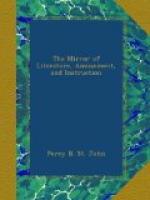* * * * *
But where, oh where is Ada gone?
She is kneeling in a dungeon lone;
Her fillet of snowy pearls has now
Fall’n from its throne on her whiter brow,
And her fair, rich tresses, like floods of gold,
Gleam on the floor so damp and cold.
Her cheek is pale, but her eye of blue
Now wears a bright and more glorious hue;
It tells of a maiden’s constancy,
Of her faith in the hour of adversity;
On a pallet of straw in that gloomy cell,
Is a captive knight whom she loves so well,
That she’s left her joyous and splendid bower
To dwell with him in his dying hour,
To pillow his head on her breast of snow,
To kiss the dew from his pallid brow;
With smiles to chase the thoughts of gloom
Which darken his way to an early tomb,
To shed no tear, and to heave no sigh,
Though her heart is breaking in agony.
M.A.J.
* * * * *
SPIRIT OF DISCOVERY.
* * * * *
PITCAIRN’S ISLAND.
The Quarterly Review (89) last published, is, indeed, a Reform Number; for all the papers, save one, relate to some species of reform or improvement.—Thus, we have papers on Captain Beechey’s recent Voyage to co-operate with the Polar Expeditions—Population and Emigration—the notable Conspiration de Babeuf—the West India Question—and last, though not least, “the Bill” itself. We have endeavoured to adopt from the first paper, some particulars of a spot which bears high interest for every lover of adventure; the reviewer’s observations connecting the extracts from Captain Beechey’s large work.
His Majesty’s Ship Blossom, Captain F.W. Beechey, sailed from England May 19, 1825, and having looked in at the usual stopping places, Teneriffe and Rio de Janeiro, proceeded round the Horn, and touched at Conception and Valparaiso, on the coast of Chili. In a few days the Blossom reached the Easter Island, of Cook. Her next visit was to Pitcairn’s Island, which the reviewer thinks “the most interesting point in the whole voyage.” We do not proceed in the outline, but “look in” at “the Island.” To this spot, as the public have for some years been aware, the Mutineers of the Bounty carried that ship, after they had deprived Capt. Bligh of his command, and turned him adrift in the middle of the Pacific Ocean.[5]
[5] Who does not recollect the delightful narrative published some years since by Mr. Mariner, in his account of the Tonga Islands; the poem of “the Island,” by Lord Byron; and countless dramatic representations of this unhappy affair. We remember an affecting version about seven years since at Sadler’s Wells Theatre: and only a few weeks since a few of its incidents were embodied in a melo-dramatic piece called “Neuha’s Cave, or the South Sea Mutineers,” at Covent Garden Theatre.
In the end, only one white man, old Adams, remained alive of the mutineers who had landed. Of these, only one died a natural death; another was killed by accident; six were murdered; and but one remained to tell the tale.




